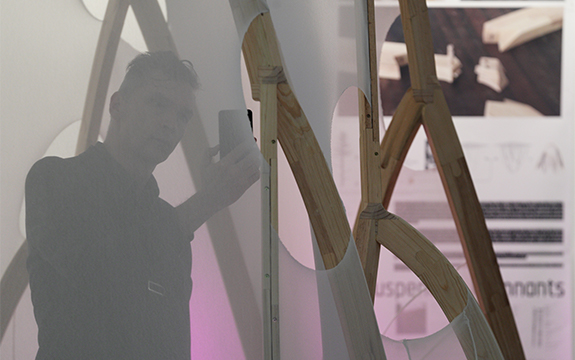Swinburne design academics feature at the Future Prototyping Symposium and exhibition

Swinburne at the Future of Prototyping exhibition and symposium, photography by James Rafferty.
In summary
- Swinburne design academics Dr Gregory Quinn and Canhui Chen exhibited their work and research projects at the Future Prototyping Symposium in March.
- Projects exhibited included a disaster relief shelter and AR construction device for STEM.
- Another project showcased at the exhibition, FabPod ll, supports privacy and speech optimisation in workspaces.
The Future Prototyping Symposium and exhibition opened on March 16, but like many events, had to close its doors due to the COVID-19 pandemic. Hosted at the University of Melbourne Dulux Gallery, the symposium featured speakers from Swinburne, University of Melbourne, RMIT, University of Queensland and industry partners.
Major Discipline Coordinator for Swinburne Architectural Engineering, Dr Gregory Quinn and Lecturer in Architecture, Canhui Chen exhibited their work and research projects.

Future of Prototyping exhibition and symposium, opening night, photography by James Rafferty

Future of Prototyping exhibition and symposium, opening night, photography by James Rafferty
Quinn’s design for a disaster relief shelter, SheltAir, makes use of pneumatic formwork for assembly and erection. The scaled models at the exhibition represented SheltAir in a desert setting, similar to a case study considered for Syrian refugees in Jordan.

SheltAir exhibit, photography by James Rafferty
Quinn has since been invited to participate and exhibit SheltAir in Geneva next year, in the Open House exhibition for new designs in temporary housing, located on a site next to the United Nations.
“This seems particularly relevant in a world full of crises and now a pandemic,” says Quinn.
Quinn’s second work, constructAR, is an augmented reality construction device that makes learning in STEM more engaging, effective and fun. Quinn has patented the constructAR technology with Swinburne and in his role as the Faculty of Health, Arts and Design (FHAD) 2020 Innovation Fellow, he is continuing development and commercialisation of constructAR with support from an accelerator program. A pilot study is planned to test constructAR in classrooms with educators across Melbourne this year.

constructAR construction device on display, photography by Gregory Quinn
Lecturer in Architecture at Swinburne, Canhui Chen exhibited three collaborative projects. The Mycelium Structure Prototype #3 project takes a multidisciplinary approach and draws inspiration, technology and knowledge from biological science, algorithmic design and digital fabrication.
The mycelium project is developed and integrated into a series of annual collaborative workshops with the IAAC Global Summer School and hosted by Swinburne. Participants collaborate with biologists, engineers, designers and architects to probe, experiment with and test bio-materials to explore their fabrication potential and performance qualities.

Mycelium Structure Prototype #3 project on display, photography by James Rafferty
The second project in the exhibition, FabPod ll, investigates the need for privacy and speech optimisation in open work areas. In this design, intricate and customised variations of geometry and materials create novel approaches to digital fabrication. For the Future of Prototyping exhibition, interactivity was added to the window structure so it could respond to the audience.

Fab Pod ll at the Future of Prototyping exhibition, photography by Canhui Chen
The third exhibit, the Suspended Remnants Pavilion is designed and fabricated using a digital model that combines funicular geometry with a material inventory constraint. Constructed from utility-grade sawn timber, the pavilion was a winning entry in an international competition and exhibition organized by the International Association for Shell and Spatial Structures (IASS) in Barcelona last year. The pavilion is created through a Swinburne partnership with the University of Queensland, ARC Future Timber Hub and Hyne Timber.

The Suspended Remnants Pavilion, photography by James Rafferty and Canhui Chen

The Suspended Remnants Pavilion, photography by James Rafferty and Canhui Chen
“We manufactured the pavilion in Australia in 2019 using waste material, took the pieces to Barcelona in our luggage and built and exhibited it there in October. The pieces were shipped back to Australia and the pavilion was assembled again for the exhibition,” explains Chen.

Canhui Chen giving his floor talk, photography by James Rafferty
A virtual tour of the Future of Prototyping exhibition and catalogue provides a lasting record of this inspiring event. Individual symposium sessions can be viewed online.
Media enquiries
-
Media Enquiries
Related articles
-

- Design
- Astronomy
- Technology
- University
Swinburne ‘Rock Muncher’ takes part in Australian Rover Challenge
A multidisciplinary student team from Swinburne University of Technology competed in the 2024 Australian Rover Challenge held in Adelaide, South Australia.
Thursday 11 April 2024 -

- Design
Swinburne and Scope design accessible USB hubs to improve lives
Swinburne’s Centre for Design Innovation has been researching and designing technology to improve the lives of those living with disability.
Tuesday 02 January 2024 -

- Trades
- University
- Sustainability
Transforming Indigenous housing with future-forward solutions
Swinburne University of Technology has launched a new Indigenous Building Co-Fab initiative. The initiative will tackle housing affordability and sustainability by creating innovative pathways to upskilling communities themselves.
Tuesday 19 December 2023 -

- Design
Young Swinburne designers help build luxury brand
Young Swinburne designers are helping to build the range for a new Melbourne-based luxury product brand, Lood.
Tuesday 31 October 2023 -

- Social Affairs
- Design
Swinburne helps Pasifika youths develop life skills and thrive
Up to 100 Pasifika youths have graduated from Swinburne’s Discovery Sprint program, where young people can gain skills that could kickstart careers in in-demand industries.
Monday 02 October 2023

